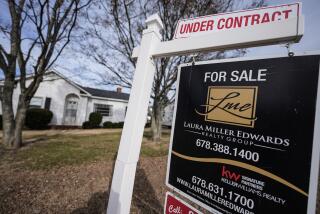Dollar Drop Lures Europeans
- Share via
Once upon a time it was essential to include the who, why, what, when and where in the lead of a news story. Now let’s use that device to look at varied aspects of the 1988 total real estate field.
--Who? They are Europeans buying U. S. real estate at an increasing pace. The Jones Lang Wooton brokerage firm reports that German, Dutch, French and British investors are enticed by the decline in the value of the American dollar and inherent attractiveness of U. S. property.
The Europeans make deals less conservative than those demanded by Japanese buyers. An example: the recently restored Army Navy Club Building, only one long block north of the White House, has been sold for in excess of $40 million to a Dutch pension fund. JLW arranged the deal.
The 12-story, 103,000-square-foot building was tastefully restored and five levels excavated below grade for parking. Law firms, the Washington bureau of the New York Times and Shearson-Lehman are principal tenants in the 77-year-old landmark structure.
--Why . . . are new houses so costly? economist Michael Sumichrast cites the “enormous jump” in urban area land prices. Thirty years ago, when a fine new house could be bought for less than $40,000 here, the cost of a finished lot accounted for only 11% of the sale price of a new house.
Now, slightly larger new single-family houses generally range over $200,000, and the land cost share can be more than 25%. Sumichrast told readers of his newsletter that the share of land cost in the sale price of a $199,000 home in Southern California now is 29.4% ($58,397), leaving less than 40% of the total for actual direct construction costs.
The rest goes for financing costs, marketing, overhead and profit. Erosion control accounts for 12% of land development costs and fees, assessments are 5.6% and building permits take 10.9%.
--What . . . is worrisome on the environmental horizon? About 500 District of Columbia-area developers, brokers and lenders were warned that it may be impossible to protect themselves if hazardous waste is discovered on their property.
California attorney Bruce Hyman of Landels, Ripley & Diamond, advised “more diligence” in protecting against liability claims regarding hazardous waste.
He warned that property owners, former owners, lenders, tenants, managers and, in some cases, even real estate brokers can be held liable for cleaning up hazardous waste in commercial properties because the Environmental Protection Agency has the power and legal muscle to get really tough.
--When? This when concerns what happens when the federally mandated Veterans Administration mortgage rate is lowered by a full percentage point. That happened on Jan. 29, when the rate was reduced to 9.5%.
That was good news for home buyers. That 1% drop meant a savings of about $1,000 over a year for a home buyer getting a $100,000 loan. But mortgage lenders told Real Estate Finance Today that the lower rate also meant that discount points (paid by sellers to compensate for below-market rates) went up as many as three points from par due to the change.
That meant paying 3% on that same $100,000 mortgage--$3,000. A veteran is not permitted to pay discount points on VA loans, so the seller has to pay them.
Terry Ward, president of Arden Mortgage in Walnut Creek, Calif., said the problem is mitigated in his area because contracts are written with a maximum number of points, usually two or three, that sellers know they might have to pay if there’s a rate decrease during the selling-settlement period.
--Where? That’s in wealthy Bethesda, Md., a proposal to build a 12-story, 240-suite housing complex for senior citizens that was harshly rapped by neighbor groups and then unanimously rejected by the Montgomery County (Md.) Planning Board as too big to be compatible in the neighborhood.
The facility also would have included a 60-bed nursing facility. The builder/developer wanted to develop a 16-acre site, using a special zoning exception, for luxury housing for older persons on land now zoned for townhouses.
The complex would be one of those life-care facilities, for which residents pay a one-time entrance fee (upward from $145,000 to $295,000 in this instance) and then residence fees of $895 to $1,545 a month. Meal service and nursing home care are guaranteed for later years.
If the zoning appeals board also vetoes the project, the builder plans to erect 150 luxury townhouses on the same site.
More to Read
Inside the business of entertainment
The Wide Shot brings you news, analysis and insights on everything from streaming wars to production — and what it all means for the future.
You may occasionally receive promotional content from the Los Angeles Times.










